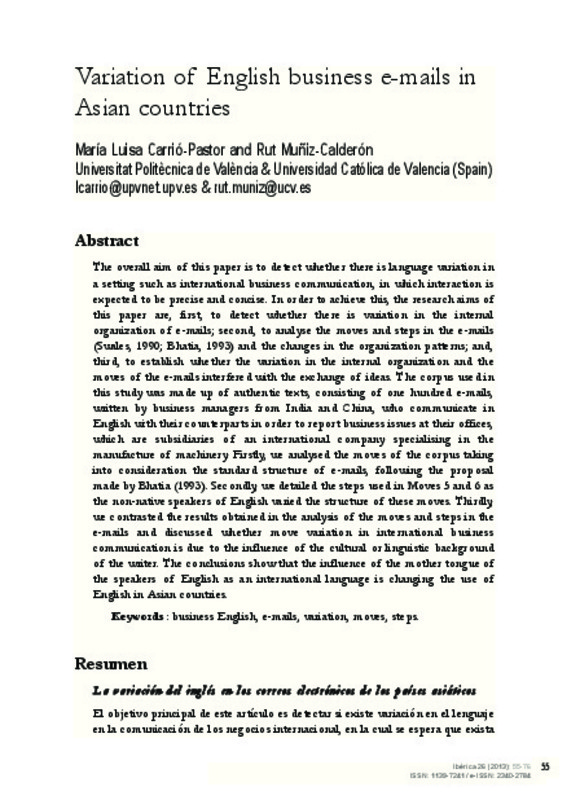JavaScript is disabled for your browser. Some features of this site may not work without it.
Buscar en RiuNet
Listar
Mi cuenta
Estadísticas
Ayuda RiuNet
Admin. UPV
Variation of English business e-mails in Asian countries
Mostrar el registro sencillo del ítem
Ficheros en el ítem
| dc.contributor.author | Carrió Pastor, Mª Luisa
|
es_ES |
| dc.contributor.author | Muñiz Calderón, Rut
|
es_ES |
| dc.date.accessioned | 2017-02-21T14:52:16Z | |
| dc.date.available | 2017-02-21T14:52:16Z | |
| dc.date.issued | 2013 | |
| dc.identifier.issn | 1139-7241 | |
| dc.identifier.uri | http://hdl.handle.net/10251/78135 | |
| dc.description | Ibérica 26 (Número monográfico sobre “Comunicación intercultural e internacional en el mundo de los negocios” / Special issue on “Intercultural and international business communication”) (Fall 2013) | es_ES |
| dc.description.abstract | [EN] The overall aim of this paper is to detect whether there is language variation in a setting such as international business communication, in which interaction is expected to be precise and concise. In order to achieve this, the research aims of this paper are, first, to detect whether there is variation in the internal organization of e-mails; second, to analyse the moves and steps in the e-mails (Swales, 1990; Bhatia, 1993) and the changes in the organization patterns; and, third, to establish whether the variation in the internal organization and the moves of the e-mails interfered with the exchange of ideas. The corpus used in this study was made up of authentic texts, consisting of one hundred e-mails, written by business managers from India and China, who communicate in English with their counterparts in order to report business issues at their offices, which are subsidiaries of an international company specialising in the manufacture of machinery. Firstly, we analysed the moves of the corpus taking into consideration the standard structure of e-mails, following the proposal made by Bhatia (1993). Secondly, we detailed the steps used in Moves 5 and 6 as the non-native speakers of English varied the structure of these moves. Thirdly, we contrasted the results obtained in the analysis of the moves and steps in the e-mails and discussed whether move variation in international business communication is due to the influence of the cultural or linguistic background of the writer. The conclusions show that the influence of the mother tongue of the speakers of English as an international language is changing the use of English in Asian countries. | es_ES |
| dc.description.abstract | [ES] El objetivo principal de este artículo es detectar si existe variación en el lenguaje en la comunicación de los negocios internacional, en la cual se espera que exista una interacción precisa y concisa. Para poder responder este objetivo general, las cuestiones que se abordan en este artículo son, primero, detectar si existe variación en la organización interna de los correos electrónicos; segundo, analizar los movimientos y pasos que se siguen en los correos electrónicos (Swales, 1990; Bhatia, 1993) y los cambios en los patrones de organización; y, tercero, establecer si la variación en la organización interna y los movimientos de los correos electrónicos interfieren en el intercambio de ideas. El corpus utilizado en este estudio está compuesto por textos reales y consiste en cien correos electrónicos escritos por empresarios de India y China, que se comunican con sus socios para informar sobre temas de negocios en sus oficinas, sedes de una empresa internacional que está especializada en la fabricación de maquinaria. En primer lugar, analizamos los movimientos del corpus considerando la estructura estándar de los correos electrónicos, siguiendo la propuesta de Bhatia (1993). En segundo lugar, detallamos los pasos que se utilizaron en los Movimientos 5 y 6 ya que hallamos variación en esos dos movimientos. En tercer lugar, comparamos los resultados obtenidos en el análisis de los movimientos y los pasos en los correos electrónicos y comentamos si la variación de los movimientos en el inglés de los negocios se debe a la influencia de la cultura o los antecedentes culturales del escritor. Las conclusiones demuestran que la influencia de la lengua materna está influyendo en el uso de una lengua franca como es el inglés en los países asiáticos. | es_ES |
| dc.language | Inglés | es_ES |
| dc.publisher | Asociación Europea de Lenguas para Fines Específicos (AELFE) | es_ES |
| dc.relation.ispartof | Ibérica | es_ES |
| dc.rights | Reconocimiento (by) | es_ES |
| dc.subject | Variation | es_ES |
| dc.subject | Business English | es_ES |
| dc.subject | E-mails | es_ES |
| dc.subject | Moves | es_ES |
| dc.subject | Steps | es_ES |
| dc.subject.classification | FILOLOGIA INGLESA | es_ES |
| dc.title | Variation of English business e-mails in Asian countries | es_ES |
| dc.title.alternative | La variación del inglés en los correos electrónicos de los países asiáticos | es_ES |
| dc.type | Artículo | es_ES |
| dc.rights.accessRights | Abierto | es_ES |
| dc.contributor.affiliation | Universitat Politècnica de València. Escuela Técnica Superior de Ingeniería Geodésica, Cartográfica y Topográfica - Escola Tècnica Superior d'Enginyeria Geodèsica, Cartogràfica i Topogràfica | es_ES |
| dc.description.bibliographicCitation | Carrió Pastor, ML.; Muñiz Calderón, R. (2013). Variation of English business e-mails in Asian countries. Ibérica. 26:55-76. http://hdl.handle.net/10251/78135 | es_ES |
| dc.description.accrualMethod | S | es_ES |
| dc.relation.publisherversion | http://www.aelfe.org/?s=revista&veure=26 | es_ES |
| dc.description.upvformatpinicio | 55 | es_ES |
| dc.description.upvformatpfin | 76 | es_ES |
| dc.type.version | info:eu-repo/semantics/publishedVersion | es_ES |
| dc.description.volume | 26 | es_ES |
| dc.relation.senia | 253286 | es_ES |
| dc.identifier.eissn | : 2340-2784 |






